Algebra 1 Regents Everything You Need to Know
Are you a student at a public high school in New York Land? Then you must laissez passer a math Regents exam in lodge to graduate and get your diploma. I of these exams is Algebra ane Regents, which tests your agreement of an assortment of algebra-related concepts and laws, from exponents and equations to functions and probability. The next NYS Algebra regents exam will be held on Midweek, June xvi, 2022 at ix:15 am. Read on to learn exactly what the Algebra 1 Regents exam entails, what kinds of questions yous tin expect, what topics you should know, and how you can ensure you laissez passer it. The Algebra 1 Regents exam is a three-hour math test consisting of 37 questions across four parts. Here'south an overview of the structure of the test: Part I consists of all multiple-selection questions, whereas Parts II through Four take what are called synthetic-response questions for which you write out your work to show how you found the correct answer. For each multiple-choice question, you'll go four answer choices (labeled 1-4) to option from. To go full points for each constructed-response question, you must do the following per the official instructions: "Clearly betoken the necessary steps, including appropriate formula substitutions, diagrams, graphs, charts, etc. Utilize the data provided for each question to make up one's mind your answer. Note that diagrams are not necessarily drawn to calibration." Basically, yous take to evidence your work! If yous put downwards just the right respond, you'll net 1 bespeak—but that's information technology. You lot won't go scrap paper to use, but you may employ whatsoever blank spaces in the test booklet. Yous volition be given one sheet of fleck graph newspaper. Note that annihilation written on this paper will not be scored. The following equipment must exist provided to you for the Algebra 1 Regents exam: In the back of the examination booklet will be a "High School Math Reference Sheet" containing common formulas and conversions. Here's what this sheet looks similar: In this section, we expect at some sample questions from the Algebra 1 Regents test. All questions and pupil responses are taken from the August 2019 administration of the Algebra 1 Regents exam. The cost of jerseys is $\$23$ per jersey. So if there were, say, ten people on Bryan's hockey team, that would be ten $\$23$ jerseys, or $10*23$. We could therefore write 23$\bi x$ to show this same thought algebraically, with $\bi x$ representing the number of jerseys. There's also a $\$250$ onetime prepare-up fee, but because this fee doesn't depend on whatsoever particular number of jerseys—you could buy x or 100 jerseys and it would still be a $\$250$ set-up fee—we would just write it as a abiding that'south being added to the $\bi ten$. This means that our final algebraic expression should look similar this: $23x+250$ Answer option 3 matches this and is therefore the correct answer. For this short-response question, y'all must plug -two into the equation and solve. In other words, you're being asked to solve the equation if $x=-2$ (that's what $g(-ii)$ means): $g(-2)=-iv(-2)^2-three(-2)+2$ The right reply is -8. Be sure to use PEMDAS. To solve it, you have to deal with the exponent beginning (the $-2^2$ part) and then multiply everything else from left to right. Finally, y'all add together information technology all together to get the correct answer (-8). This student response got full credit for having both the correct setup and answer: At that place are two things you need to do for this question: Before you start graphing annihilation, make sure that you read the graph closely and empathize what the $\bi x$-centrality and $\bi y$-centrality mean. Whereas the $x$-axis represents the number of hours that have passed, the $y$-axis represents the total amount of snow in inches. Equally a consequence, the $x$-axis is divided up past hr, while the $y$-centrality is divided upwards past half inch. So how do you lot graph this? Permit's do it together, step by step, based on the information higher up. "For the starting time 4 hours, it snowed at an average charge per unit of one-half inch per hr." Starting from the origin of the graph, or $(0, 0)$, draw an increasing line so that it goes up 1-half inch every hr until hour 4; this should place yous at a total of 2 inches of snowfall (that's $0.five*4$), or coordinates $(four, two)$. "The snowfall and so started to fall at an average rate of ane inch per hour for the adjacent half dozen hours." From $(iv, 2)$, draw an increasing line until 60 minutes 10 that goes up a whole inch every hr. You should terminate at $(10, viii)$, indicating a full snowfall of 8 inches over the class of 10 hours. "And then it stopped snowing for 3 hours." No new snow ways nothing changes vertically (on the y-axis), giving us a horizontal line. From your current location at $(ten, 8)$, draw a apartment horizontal line from hour 10 until hr 13. "Then it started snowing over again at an boilerplate rate of one-half inch per 60 minutes for the next 4 hours until the storm was over." From the signal at $(ten, 8)$, draw an increasing line then that information technology goes up one-one-half inch every hour until 60 minutes 17. This line will have the same slope as the first line you drew. You should terminate upwardly at $(17, 10)$, meaning it snowed a total of x inches over 17 hours. Hither'due south what a correctly drawn graph looks similar. The student put down points at each hour marking to show where the full snowfall was every hr; they likewise connected the dots, which you must do if you want to become full points for this question! One time you've graphed the give-and-take trouble, it's time to figure out the overall average charge per unit of snowfall over the length of the storm. To do this, we'll have to divide the total amount of accumulated average snow (ten inches) by the total number of hours it snowed (17): $10/17=0.58823529411=0.59$ Circular your reply to the nearest hundredth of an inch, per the instructions in the trouble. This gives united states of america a total boilerplate snowfall of 0.59 inches. This long-response question is worth 6 credits and can be divided into iii parts. Here, we're existence asked to come up up with a system of equations (likely two equations) that can be used to describe the situation. While A stands for the number of Americana chickens Allysa bought, D stands for the number of Delaware chickens she bought. Allysa bought a total of 12 chickens, consisting of both Americana chickens and Delaware chickens. Therefore, we can conclude that the number of Americana chickens bought + the number of Delaware chickens bought = 12 full chickens. In algebra, this would await like this: $A+D=12$ That'due south just one equation in our system of equations. So what's the other? We know that Allysa paid a total of $\$35$ for her chickens. We also know that each Americana chicken is $\$3.75$, while each Delaware chicken is $\$2.50$. Therefore, the number of Americana chickens bought at three.75 each + the number of Delaware chickens bought at ii.50 each = 35 dollars. In other words: $3.75A+2.50D=35$ Our system of equations, so, looks like this: $A+D=12$ This 2d part of the problem is request united states of america to solve for the exact values of both $A$ and $D$ using the system of equations we constitute. To practice this, we must gear up upwardly the ii equations in such a way that one of them contains only one variable (either $\bi A$ or $\bi D$). Considering the first of our equations is the simpler one, allow's use this one to solve for $A$ in terms of $D$: $A+D=12$ Nosotros know that $A$ is equal to 12 subtracted by $D$. Now, we tin plug this into our other equation equally $\bi A$, giving us only the variable $\bi D$ to work with: $three.75A+ii.50D=35$ Solve for $D$ to discover the number of Delaware chickens Allysa bought: $3.75(12-D)+2.50D=35$ Now that nosotros take the value of $D$, we tin can plug this value of 8 into our equation and solve for $A$: $A+D=12$ The algebra shows that Allysa bought 8 Delaware chickens and four Americana chickens. Here's an example of a student'south right response: This part isn't every bit tricky every bit it looks and mostly consists of easy addition, multiplication, and sectionalization. To showtime, we must find out how many full eggs Allysa can await her 12 chickens to lay each week. Based on what we establish in Part ii in a higher place, nosotros know that Allysa has 8 Delaware chickens and 4 Americana chickens. As Role 3'due south instructions tell usa, Delaware chickens lay 1 egg a twenty-four hours, whereas Americana chickens lay 2 eggs a day. Per 24-hour interval, then, Allysa's 8 Delaware chickens lay a total of eight eggs (considering viii chickens multiplied by 1 egg each per day = 8 eggs a day). And her iv Americana chickens lay 8 total eggs every bit well (as 4 chickens multiplied past 2 eggs each per mean solar day = viii eggs each day). This means that Allysa takes in 16 eggs in full per day from both types of chickens she owns (since $8+8=xvi$). Now how many eggs do Allysa's chickens lay in a week? To find this, multiply the number of eggs her chickens lay each day (that's 16) by seven days: $16*seven=112$ Allysa's chickens lay 112 eggs a week. Only Allysa can only sell her eggs past the dozen, or in groups of 12, so nosotros need to divide this total by 12 to see how many full dozens that gives her: $112/12=9.3333=ix$ You'll demand to round down to the nearest whole number since nosotros tin can't have anything less than a full dozen. In other words, 9 dozens fit into 112. (To make 10 dozens, we would need 120 eggs.) Finally, multiply these 9 dozens by the price per dozen eggs ($\$2.l$) to come across how much money Allysa would make past the end of the week: $9*2.50=22.50$ Allysa would make $\$\bo 22.fifty$. This sample student response earned full points: The Algebra one Regents test covers the basic skills and laws taught in algebra earlier you go into trigonometry. Beneath is a more in-depth listing of the topics tested with links to our relevant SAT/Human activity guides in case you're looking to review any concepts: This chart shows what percentage of Algebra one Regents each major category tested comprises: Source: Engage NY via the New York Land Teaching Department If you lot're taking the Algebra i Regents exam to fulfill your math test requirement, then you need to ensure that yous volition laissez passer the examination. To pass, you lot must earn a scaled score of 65 or higher, which comes out to virtually 27 credits/points (out of 86). You tin employ official Algebra 1 Regents conversion charts for past tests to become a ameliorate sense of how credits translate into scaled scores. Every assistants is dissimilar, though, then the number of points you need to get a sure score can vary slightly from test to test. Here are six useful tips—both for your prep and test mean solar day—to help you laissez passer Algebra Regents. One of the best ways you can gear up for the Algebra 1 Regents exam is to utilise real, previously administered tests, which are bachelor for free on the New York Country Education Department website. Because these are actual exams administered by the NYSED, yous know yous'll be getting the most realistic examination-taking feel possible when yous use them. It's most effective to take ane practice test in the beginning of your prep, one in the heart of your prep, and one right before test twenty-four hour period. This way you lot can monitor your progress and figure out which topics, if any, you're still struggling with. Every time you lot accept a practice exam, exist sure to time yourself as y'all'll be timed on the actual exam (three hours); y'all should also have the exam in a quiet room away from others. You'll want to mimic real testing conditions every bit closely as possible so you can become a highly accurate indicator of where y'all're scoring and whether y'all're on rail to passing. After you end taking a test, score it using its answer central and refer to the educatee responses to see what kinds of answers earned total points and what graders were looking for. All the topics tested on the Algebra 1 Regents exam should be topics you already studied in depth in your algebra grade, so if you still have any old homework assignments, graded tests/quizzes, or an algebra textbook, use these to review for the Algebra 1 Regents exam and to get a clearer sense of what areas yous used to struggle with (and whether you still struggle with them). I recommend trying out some of the exercise math questions from your algebra textbook that you didn't already practice for homework or in-class practice. If you have whatsoever questions most a detail exam topic, a question type, or the scoring system, don't be afraid to talk to your algebra teacher. They want you to pass Algebra one Regents and get your high school diploma, afterwards all! See whether your teacher has any time afterward class to go over tricky concepts with yous or give yous advice on what graders look for when information technology comes to the constructed-response questions. These ii strategies—plugging in answers and plugging in numbers—are great ones to know for the Algebra ane Regents exam, particularly for the multiple-choice questions in Role I. If y'all don't know how to approach an algebra problem, you can use these tricks to assist you figure out what the answer could be. Both strategies involve the utilize of substitution of either one of the four answer choices or any easy-to-use number for a variable in an equation/arrangement of equations. You can besides use these strategies to cheque your answer and make sure that it actually works with the equation(s) provided. As you know, Algebra ane Regents consists of four parts, the outset of which is a long multiple-selection department. Only since this is arguably the easiest of the four sections, you'll want to make certain that you're non spending also much time on Part I. And since Parts II, 3, and IV are harder and worth more than points, you'll desire to save as much time equally you can for the constructed-response questions. You'll get iii hours for the exam, so try to spend no more than an hour on Office I—this gives yous about ii and a half minutes per multiple-choice question. Ideally, y'all'll also take plenty of fourth dimension at the finish of the examination to bank check your answers. Since there's no guessing penalty on the Algebra 1 Regents exam, yous should put downwards an answer for every question, fifty-fifty if you're completely stumped as to how to solve it. With the multiple-choice questions, use the process of elimination first to encounter if yous tin can whittle down the number of answer choices to 3 or even two, thereby raising your chances of getting the right answer from 25% to 33% or 50%. Another tactic is to choose a guessing number (one-iv) you lot can use when a multiple-choice problem stumps you. For instance, if your guessing number was 3, then you would pick respond choice 3 for any multiple-choice problem you lot had absolutely no idea how to solve. For the Role II, III, and IV constructed-response questions, you can get partial credit for showing at least some right work—fifty-fifty if it's just a small part of what the problem asks you lot to exercise—and so put down whatever you can! The Algebra i Regents exam is one of three math Regents exams that loftier schoolhouse students in New York tin can choose from to fulfill their graduation requirements. The test has 37 questions spread out beyond four sections: the first is a multiple-choice section, and the other three are constructed-response sections that crave you to show your work in order to earn credit. A passing score on Algebra Regents is a 65, equal to about 27 credits on the test. In terms of topics tested, the NYS Algebra Regents test covers a broad range of algebra fundamentals, from equations and inequalities to functions and polynomials. To give yourself your best shot at passing, be sure to take real practice tests, review former homework assignments and materials from your algebra class, and get help from your algebra teacher if y'all have any questions or need boosted guidance. On the day of the test, brand certain to reply every question, use unlike strategies such equally the process of elimination and plugging in answers/numbers, and organize your time so that you take more time for the constructed-response questions. Good luck! Not a fan of Algebra one Regents? No problem. If you'd rather accept a dissimilar math Regents examination for your high school graduation requirements, then check out our guides to the Geometry Regents examination and the Algebra 2 Regents test. Desire to learn more about the New York Regents Examinations? Our in-depth guide goes over what these tests are for and who must take them. You'll have to accept a science Regents exam in addition to a math one. Learn about these tests with our skilful manufactures on World Scientific discipline Regents, Chemical science Regents, and Living Environs Regents.
What'south the Format of Algebra 1 Regents?
# of Questions Question Type Points per Question Partial Credit Given? Total Points Office I 24 (#one-24) Multiple choice 2 No 48 Part II 8 (#25-32) Short response 2 Yes 16 Office III iv (#33-36) Medium response 4 Yeah 16 Part 4 one (#37) Long response half-dozen Yes 6 Total 37 — — — 86
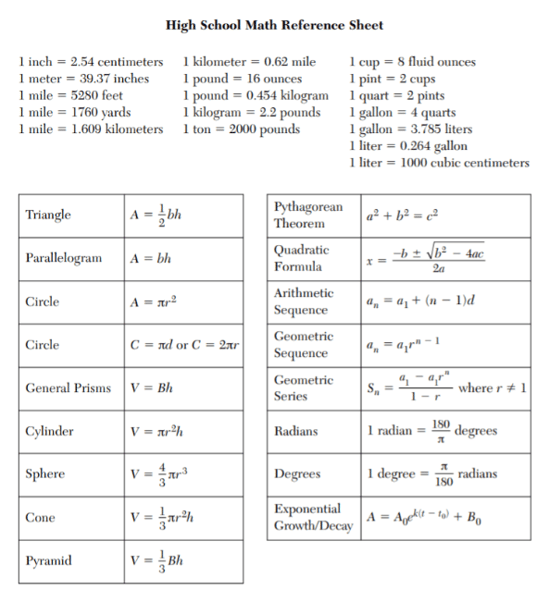
 Unfortunately, Algebra 1 Regents questions won't be this unproblematic!
Unfortunately, Algebra 1 Regents questions won't be this unproblematic! What Practice Algebra 1 Regents Questions Expect Like?
Multiple-Choice Sample Question (Office I)

Short-Response Sample Question (Role II)

$grand(-ii)=-four(4)-3(-2)+2$
$1000(-2)=-xvi+6+two$
$g(-2)=-8$
Medium-Response Sample Question (Part III)
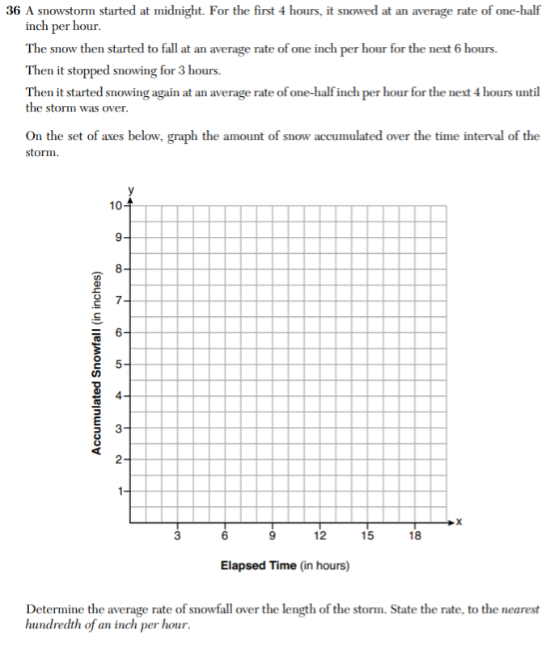
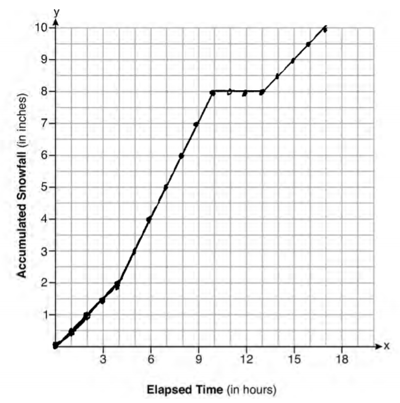
 Is ten inches of snow enough for a fox to submerge its head in?
Is ten inches of snow enough for a fox to submerge its head in? Long-Response Sample Question (Part Iv)


Function 1
$3.75A+2.50D=35$Part 2
$A=12-D$
$3.75(12-D)+2.50D=35$
$45-three.75D+2.50D=35$
$45-1.25D=35$
$-1.25D=-10$
$-1.25D=-x$
$D=8$
$A+8=12$
$A=12-8$
$A=4$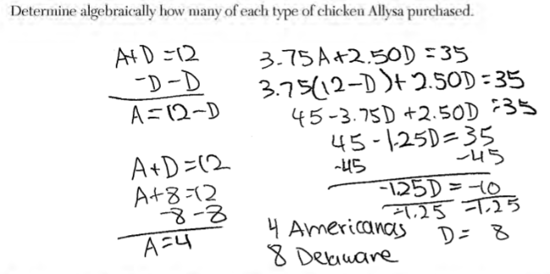
Function 3
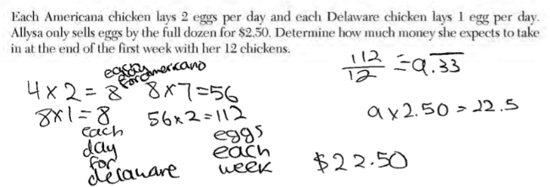
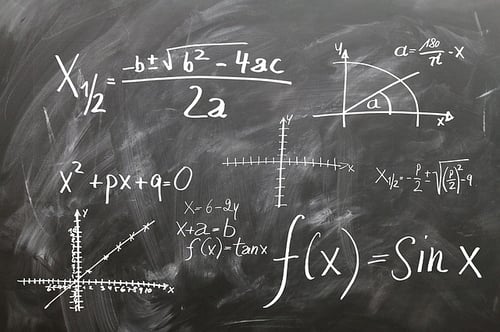
What Topics Does Algebra 1 Regents Cover?
Category Domain Topics Percentage of Test by Credit Number & Quantity Quantities Reason quantitatively and apply units to solve problems 2-8% The Real Number System Use properties of rational and irrational numbers Algebra Seeing Structure in Expressions Translate the structure of expressions fifty-56% Write expressions in equivalent forms to solve problems Arithmetic with Polynomials and Rational Expressions Perform arithmetic operations on polynomials Sympathise the relationship between zeros and factors of polynomials Creating Equations Create equations that describe numbers or relationships Reasoning with Equations and Inequalities Understand solving equations as a process of reasoning and explicate the reasoning Solve equations and inequalities in one variable Represent and solve equations and inequalities graphically Solve systems of equations Functions Interpreting Functions Empathize the concept of a function and utilise function notation 32-38% Interpret functions that arise in application in terms of the context Analyze functions using different representations Building Functions Build a function that models a human relationship between two quantities Build new functions from existing functions Linear, Quadratic and Exponential Models Construct and compare linear, quadratic, and exponential models and solve problems Interpret expressions for functions in terms of the situation they model Statistics & Probability Interpreting Categorical and Quantitative Data Translate linear models five-10% Summarize, stand for and translate data on two chiselled and quantitative variables Summarize, stand for and interpret data on a single count or measurement variable  In order to become your high school diploma, you'll need to pass NYS Algebra Regents.
In order to become your high school diploma, you'll need to pass NYS Algebra Regents. How to Pass Algebra Regents: half dozen Essential Tips
#i: Monitor Your Progress With Real Practise Tests
#2: Review Topics Using Class Materials
#iii: Consult Your Math Instructor every bit Needed
#iv: Plug In Answers and Numbers
#5: Use Your Time Wisely
#6: Respond Every Single Question
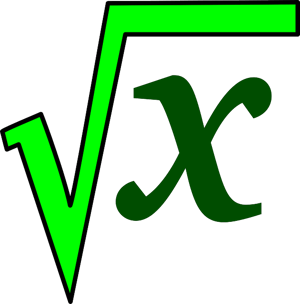
Key Takeaways: What to Know Nigh Algebra one Regents
What's Next?

Well-nigh the Author
Hannah received her MA in Japanese Studies from the University of Michigan and holds a bachelor's degree from the University of Southern California. From 2013 to 2015, she taught English in Japan via the JET Program. She is passionate well-nigh education, writing, and travel.
Source: https://blog.prepscholar.com/algebra-1-regents-review
Post a Comment for "Algebra 1 Regents Everything You Need to Know"